- Port of departure: Puerto Chiapas (Marina Chiapas), Mexico
- Departure date and time: 4:45pm on
Monday, October 7 - Port of arrival: Bahia del Sol (Estero Jaltepeque), El
Salvador - Arrival date and time: 9:00am on
Saturday, October 12 - Miles traveled: 260 nm
- Travel time: 4 days, 15 hours and 45
minutes (156 hours) - Engine hours: 1105.5 – 1135.5 – 30
hours - Fuel consumption: 12 gallons
- Fuel economy: 21.6 mpg
- Forecast: Well, we paid particular
attention (as we usually do) to the forecasts for wind and waves on the
different forecast sites…conveniently overlooking (or not giving much weight
to) the pressure and precipitation forecasts. The wind forecasts showed light
and variable winds, generally coming from the SW and never exceeding 10 knots.
The wave forecast showed waves in the 1 to 2 meter range for the entire week
coming from the W/SW. During the week we would be flanked to the north by a
blow in the Tehuantepec and a Papagayo (similar to the T-Peckers) in Nicaragua. - Tides and currents: We left Chiapas towards the end
of the flood and entered Bahia del Sol at slack tide after the flood. The
current on the way down the coast appeared to be working against us the entire
time ranging from 0.2 to 1.5 knots. - Navigation notes: We decided to remain
10-15 miles offshore to stay clear of reefs and shoals. We encountered many
piles of floating debris, including large dead heads, especially as we got
closer to land. We also encountered many fishing pangas that were stringing net
between floating buoys flying black flags. We did our best to determine where
the nets were and avoid them, though it seems that they are weighted. - Maintenance notes: See our two previous
posts about all the boat projects we took on (and accomplished) in Chiapas – one post here
and the second post here. The highlights: our bottom was clean; we brought our
new old fuel tank online; we installed a new backstay; our Ham radio was
serviced…all good things. After this trip a couple of things need some TLC: the
Doctor (our autopilot) is on the fritz again; our main sail took a bit of a
beating and needs to be reinforced; the tracks on the main sail need to be
greased; and, we noticed that there’s exhaust coming out of the water output
for our engine, which shouldn’t be happening. - Lessons learned: #1 In Central America,
during rainy season, daytime is for resting and nighttime is for worrying and
praying. #2 Pay closer attention to precip and pressure forecasts. #3 Think
seriously about investing in a barometer. #4 That big, dark, scary cloud bank
on the horizon that spitting rain drops like bullets, breathing 40 knot gusts
and hurtling bolts of lightning – yeah, that’s coming for you.
Be
forewarned…this will be a long post. A lot happened on this passage.
We had
heard stories from numerous friends about their transit of the Central American
coastline during this time of year. It is rainy season after all. The weather
is extremely localized and highly variable. There are frequent squalls and it
gets very very wet (hence rainy season). Two of our cruiser friends got caught
in squalls with too much sail area up and were pinned against the violent
ocean, water spilling into their cockpit and cabin. It was these stories we kept
in mind as we said our farewells at Marina Chiapas and headed for the sea.
Ironically, these foreboding stories didn’t tamper our overflowing excitement
to be on the boat again, on the ocean, moving, sailing. It had been over 4
months and we were eager to be on the open water, though a bit fearful that we
both might be rusty from the lack of recent practice (not to mention the
diminished upper body strength that results from spending four months of not sailing).
I am
happy to report to you that we aren’t rusty at all. We had cleared the jetties
at Puerto Chiapas
by only a mile or so before we decided it was time to hoist the sails. The
rhythm returned to us, the steps, the dance, and without any hesitation or
stumbles we were sailing along with10 knots of wind at our back. As far as the
upper body strength goes, my arms are definitely more on the jello end of the
spectrum.
Clearing
out of Mexico,
although easy, took longer than we expected, so we actually didn’t leave port
until close to 5pm, a mere two hours from sunset. So as soon as the sails were
up I was busy preparing a dinner of chow mein with sweet and sour “chicken” (in
quotations because it was some weird hybrid of chicken, turkey and vegetable
protein coated in breading). Over land, a thick cloud bank threatened to spill
out over the ocean, but the storms left us untouched that first night and the
wind allowed us to keep our sails more or less full, even though our average
was slow (2.5 to 3 knots).
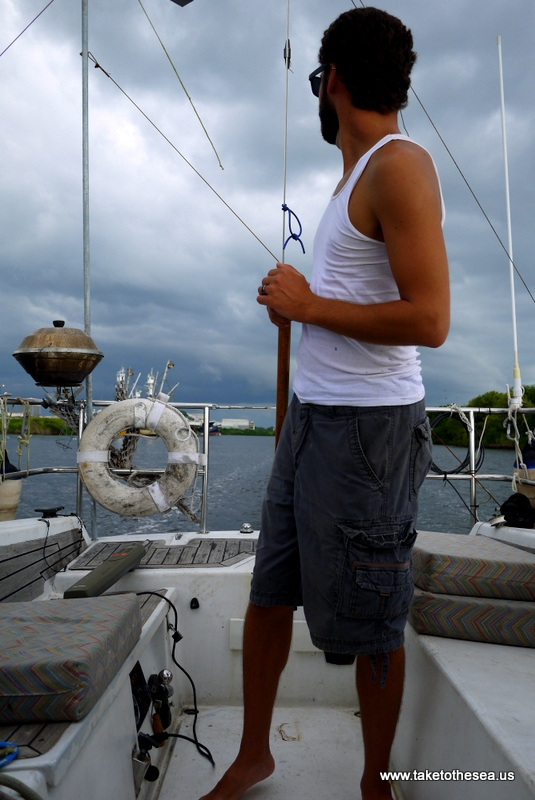 Is that coming for us? Turns out it wasn’t. The one time we were spared.
Is that coming for us? Turns out it wasn’t. The one time we were spared. 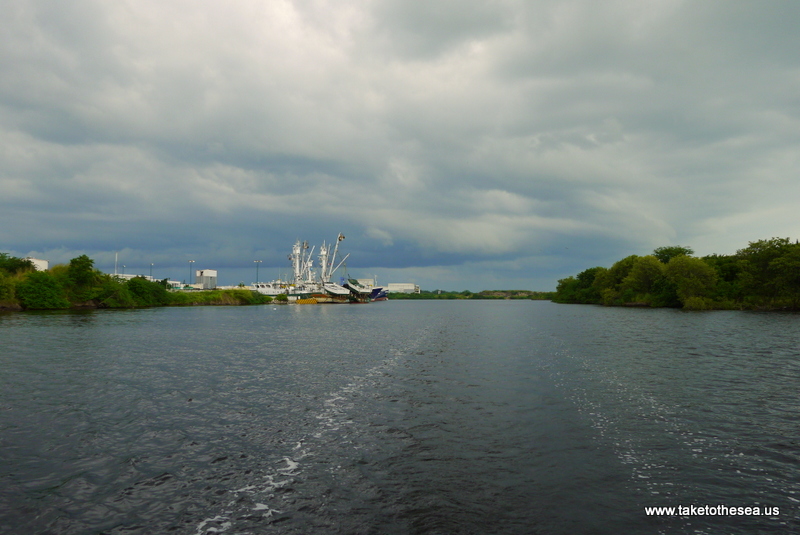 Leaving Puerto Chiapas.
Leaving Puerto Chiapas. 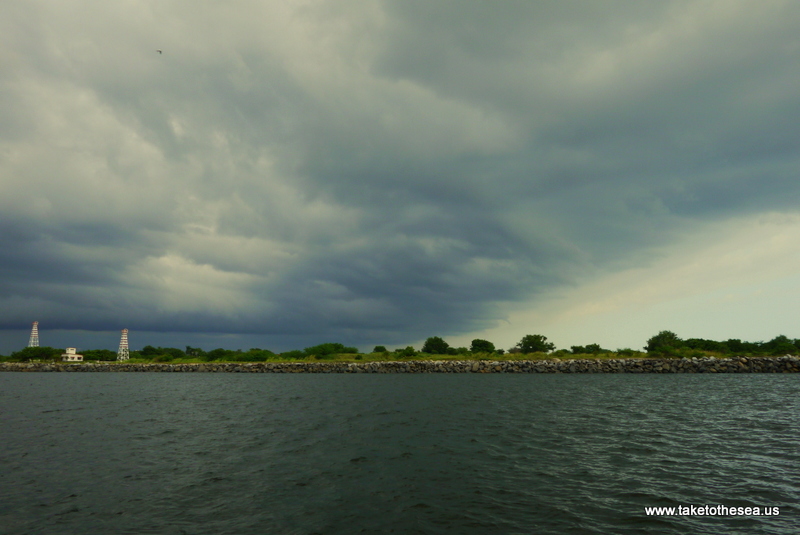 Las Escaleras – the jettties at the entrance to Puerto Chiapas and a storm front.
Las Escaleras – the jettties at the entrance to Puerto Chiapas and a storm front. 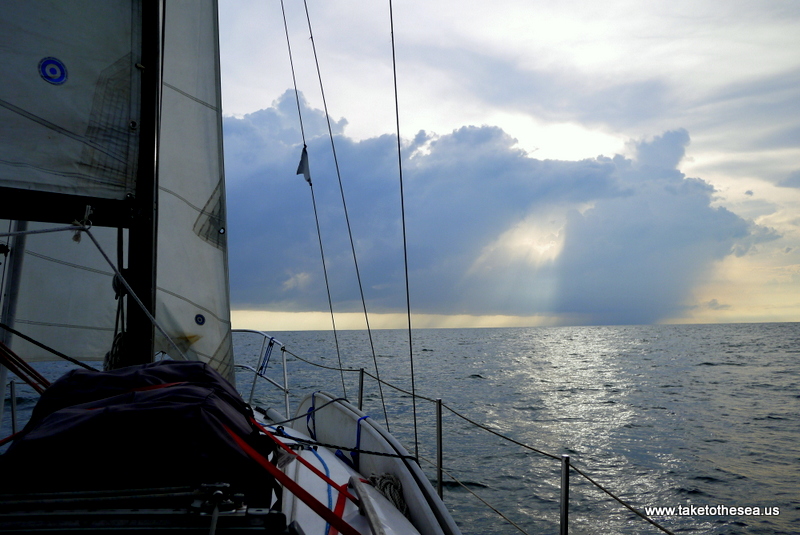 Rain cloud at sunset.
Rain cloud at sunset.
The days that followed were much the same – very light winds, usually on our nose, and an unbearably hot sun. We sailed upwind when we could, bobbed around a fair amount when we couldn’t, and turned the motor on when the rocking and rolling became intolerable. During our first 24 hours we had barely traveled 50 miles, which is less than a 2.5 knot average. The days were slow, lazy, uneventful, hot, and even kind of boring, lulling us into a tropical daze. Like the candy on the witch’s house, the days didn’t alert us to the terror that was looming, merely biding its time, waiting until we were nice and plump and totally unassuming.
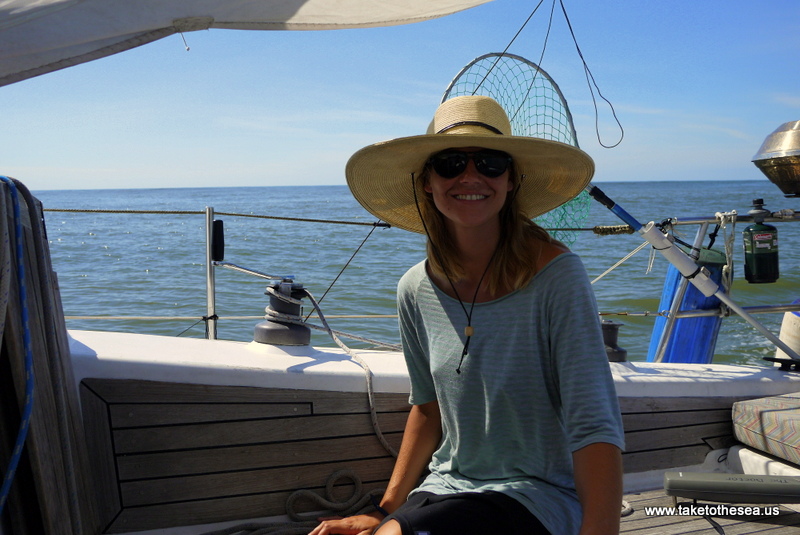 This was when I was still having some fun.
This was when I was still having some fun. 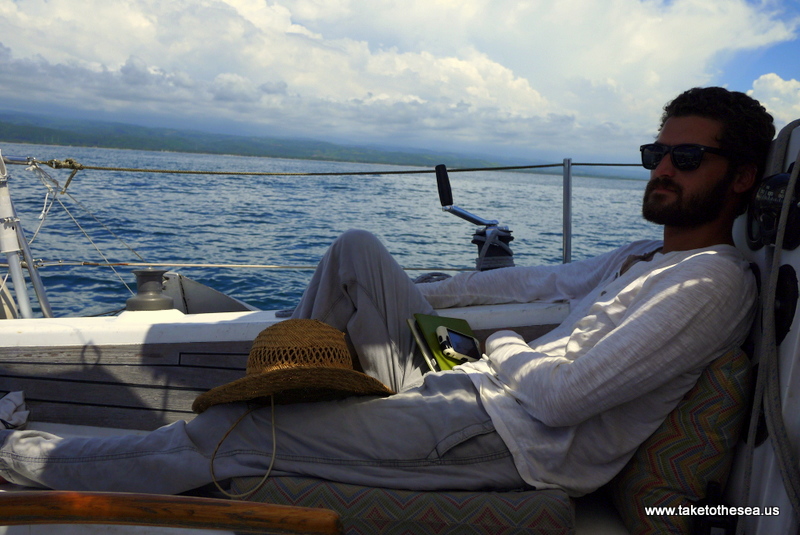 Chllaxing.
Chllaxing. 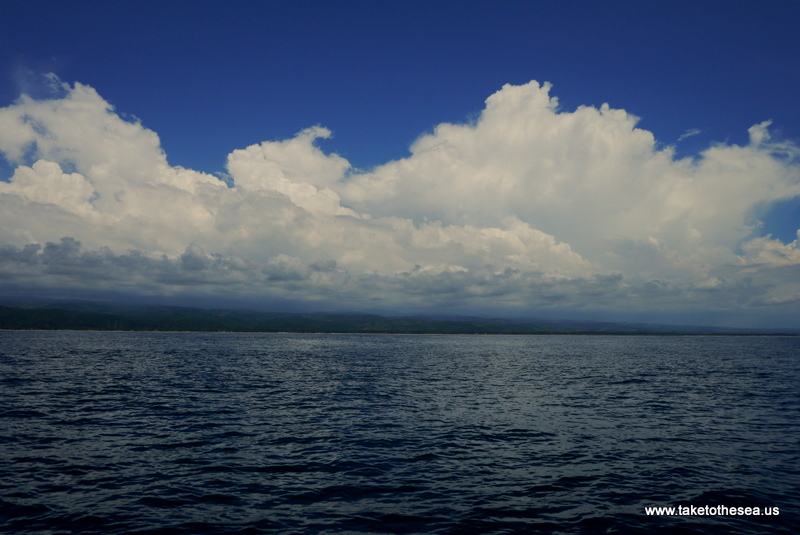 Clouds stacking up on land.
Clouds stacking up on land.
On our
second night, I popped my head up to get the download from Jeff about his
observations while on watch. There had been a number of big thunderheads in
front of us, building on land, that seemed to diffuse once they reached the
ocean and now just looked like low hanging clouds. “The clouds look fairly
benign now.” Jeff reported. Famous last words. We couldn’t see what was
towering over them.
Just
as we finished our tacos and before we had a chance to adequately clean up the
mess, one of the clouds on our starboard side was reaching down towards the water
and began to spill rain. “I think that one is coming for us.” I theorized,
though the wind direction didn’t clearly indicate that we were in its path.
“Then let’s get ready for it,” Jeff responded. We changed our course away from
the heaving cloud in hopes that we might be able to avoid it. Every loose
kitchen item was dumped into our sink to be dealt with later. The hatch was
dogged close and anything that might choose to fly was stowed away.
The
wind changed direction, now blowing out from the center of the squall, and
escalated to 20 knots in a matter of seconds. I took the stick from the Doctor
and Jeff reefed the main. Jeff had his hand on the jib sheet (unfortunately it
was our big genoa rather than our little working jib), ready to let it fly when
the 40 knot gust hit us. The jib flapped violently in the wind as I freed the
halyard and Jeff collected the sail on the foredeck. Our reefed main was
keeping us steady, but in the sudden, surprising burst of wind a seam had worked
itself loose and was starting to separate. We lowered the main rather than
letting our small jib do all the work. We turned downwind to make the wind and
mounting waves more bearable. On this passage we decided to keep a considerable
distance from shore (10-12 miles) to avoid near shore shoals and reefs. It was
a decision we were glad for now as the squall forced us towards the lee shore.
What
we didn’t anticipate was that a bigger storm front was beginning to exert
itself on our port side and would eventually overpower the smaller squall and
trap us in very confused seas with wind waves from the east and west on top of
swell from the southwest (read: gross and uncomfortable). There was rain and
lightning, but nothing like we would experience in the coming days. With the
wind on our port quarter, the storm blew us back out to sea. We were far from
alone out on the high seas; small lights illuminated at least four or five
fishing pangas, allowing us to see and dodge them. I’m continually amazed at
the resilience of the fishermen here – how much fierce weather they can
withstand in their small, open motorboats.
In the
distance Jeff spotted a floating city (i.e. a cruise ship). Nonchalantly, he
asked if I would hail the cruise ship to ask if they could provide any
information on the size and likely duration of the storm we were enduring
(their systems are undoubtedly more sophisticated than our own). I’m radio shy
to begin with and the thought of calling up a cruise ship on the radio just
sounded silly. Jeff is more familiar with life on a cruise ship, having worked
on one in his younger years. The ship had been home, the crew his community.
“We’re all mariners,” he reminded me “and we’re all in this storm together.”
Jeff
got on the radio: “Cruise ship, cruise ship, cruise ship, this is sailing
vessel Serenity, do you copy?” And, almost as if they had been anticipating our
call, they responded without skipping a beat. After looking at all of their
fancy instruments they informed us that the wind, which was now down to only 25
knots, and the lightning would last for another half hour, but the rain was
likely to last all night. We motored through the sloppy seas until the winds
died down to around 15 knots. On one of our shift changes we raised the working jib (since the main was out of commission) and continued at a steady, but slow pace.
Two
squalls in one night was two too many. We had storms every night thereafter,
though each storm had a slightly different feel to it and we approached them
with different strategies.
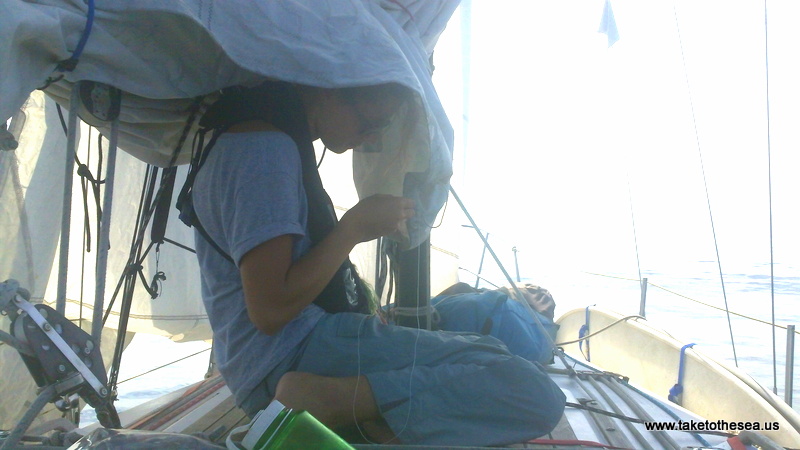 Repairing the main sail and hiding from the sun.
Repairing the main sail and hiding from the sun.
Storm #2
I
could see this storm at a distance and was hopeful that we would miss it. It
was many miles from us and we had a wind at our side, from land, that gave me
false hope that this dark cloud bank would be blown out to sea. We were sailing in a
12-15 knot breeze with our reefed main and small jib (much easier for one
person to handle in the event of a squall), which gave me some comfort. Every
five minutes I looked up to track the progress of the black clouds and was
displeased to discover that they appeared to be marching towards us. Sure
enough the wind shifted, it was light at first, but it was directly on our
nose. The storm, which stretched for miles and miles out to sea, was coming.
I descended into the dark cabin and gently woke Jeff up.
“We’re at the leading edge of a storm, babe, could you get up and give me a
hand?”
“We’re at the what? When did this happen?” A rude
awakening.
“I’ll tell you about it when you come up.” I put on my foul
weather gear, took control from the Doctor and tacked towards land where I
could see a sliver of salvation. The storm was now clearly visible. A solid
sheet of rain was backlit by bolts of lightning and it was moving quickly
towards us.
By the time Jeff was fully dressed an on deck (which didn’t
take long) we were sailing into 25 knots of wind with gusts to 30. The force of
the wind was strong, but our sail area could handle the blow. As the lightning
and rain approached we had enough time to parse through the different
strategies we’d talked about earlier in the day. We decided to heave to, which
for those non-boaters out there basically means you try to configure your sails
in such a way to keep you pointed about 45° from the wind with your bow towards
the waves. Sailors have used this strategy to ride out hurricanes and we
thought now would be a good time to test it out. We backfilled our working jib
and lashed our tiller downwind. It worked, but not as well as we hoped.
Everything felt much less dramatic, but we were 70 – 90° from the wind which
had us nearly broadside to the waves. Fortunately the wind waves were small and
didn’t put us in any danger. We have some work to do to perfect this technique.
We remained in the cabin as the storm passed overhead,
barely inching forward in the onslaught of wind and rain. Once the storm had
passed we trimmed our sails and set off with a healthy 15 knot wind at our
side.
Storm #3
This
storm descended upon us after dinner, after night fall, before bed time. We
were sitting in the cockpit awaiting its arrival, cursing its arrival.
There’s no point in trying to rest when you see a storm gunning for you. We
held on to the hope that it might fizzle out until we felt big fat drops of
rain and saw (again) the bolts of lightening arch towards us, pointing, as if
to say you, you’re next.
On
this particular night we decided to let the Doctor (our autopilot) do the heavy
lifting from the cockpit. The sails were down and all he had to do was keep us
pointed into the storm, into the waves while we sought refuge down below. Aside
from our engine, our Doctor and our handheld radio, we killed the power to all
other gadgets.
Within
moments we had complete white out conditions. We couldn’t see anything through
the opaque curtains of rain and the blinding lightning. The wind, which had
escalated in increments in the prior storms, hit us with an unprecedented
force. Without any sails up, the wind had us heeled over at 25° angle and the Doctor
had the tiller pulled hard to port. This storm was more vicious than the prior
two. We had penetrated her heart and she was angry and she was snarling and she
was determined to make us regret the intrusion. Bolts of lightning cracked
like a whip and struck the water within several hundred yards of the boat. We
kept a watchful eye on the storm and the other marine traffic and prayed.
Storm #4
You
might be getting tired of storm stories by now, so please forgive me for
telling another, but this one was perhaps the most dramatic. Maybe it was
because we were both so exhausted. Maybe it’s because we were only miles from
our destination but knew that we would have to wait until morning light
regardless of our exhaustion or the weather or anything and I wanted to relent.
Maybe it’s because I saw bolts of lightning split the air behind my husband’s
head as he sat dutifully at the tiller. Let me back up.
Jeff
was on watch as storm #4 was approaching, so I can’t really articulate his
impending dread, but I’m sure there was dread. At dinner time the sky before us
looked remarkably clear and we were hopeful that we would be spared. No such
luck. I was deep within my dreams when Jeff stirred me: “We have another storm
coming, I just wanted to let you know so you can get ready.”
The
Doctor, wise to the evening entertainment, decided he needed the night off. He
would dutifully push, but he could not be convinced to pull the tiller. So Jeff
donned his foul weather gear and his lab goggles and gripped the tiller. Ready.
Waiting. We waited in anticipation for 30 minutes. It came as a wall, pushing
water and light and wind against our tiny home. It told us you are small. It reminded us that we are but a speck in a violent
but beautiful snow globe that we do not shake.
I read
the weather through Jeff’s reactions. I sat in the cabin and watched as each
bolt illuminated a look of shock on his face. I saw him gasp for breath through
the water that drowned the air. I saw him struggle to see as rain pounded him
and lightning blinded him. I don’t know what I believe in, but I believe that
there is something bigger than me, more powerful and I would like to believe that
this entity is capable of showing mercy. So I
brought my hands to my mouth, tilted my head forward and between the
deafening cracks I prayed: “Please have mercy upon our humble home. Please have
mercy upon our humble home. Please have mercy upon our humble home.”
I
prayed for thirty minutes as Jeff sang, guiding Serenity safely to the tail end
of the storm. When I took over the tiller I asked him “so, how was it?” His
response, a tired smile on his face: “If they sold tickets to that ride, it
would be empty every time.”
Five
nights. Four storms. Terrible passage that I hope never to repeat. But boy am I
glad to be at Bahia del Sol.
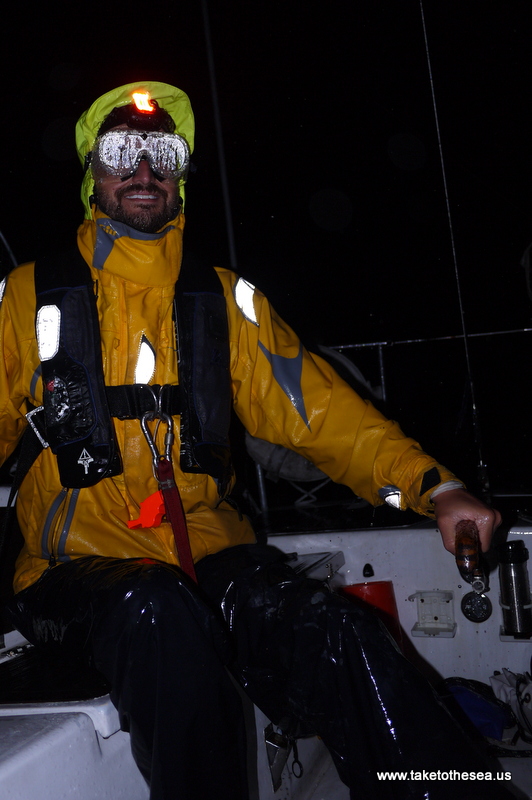 He still has a smile on his face. The best part about this…it was supposed to be my shift, but he stayed on the tiller: “There’s no point in both of us getting wet.” Love this man.
He still has a smile on his face. The best part about this…it was supposed to be my shift, but he stayed on the tiller: “There’s no point in both of us getting wet.” Love this man.
Wow. My bar pilot buddy classifies sea stories in various categories, and this one would be a "No shitter." Glad you held up to the conditions. Every experience like that teaches you something, sometimes many somethings. Remember: keep a spare set of undies handy …
You are hilarious. I’m glad to finally have a "no shitter" story in my quiver :).
eeep! Nothing like a storm to demonstrate to you just how small your boat is.
So true, so true. It’s a good reminder. A scary one, but a good one.